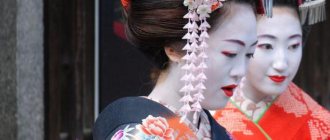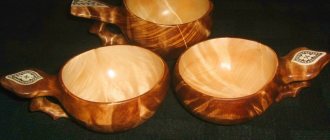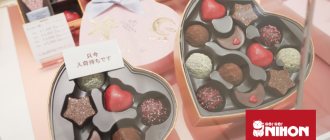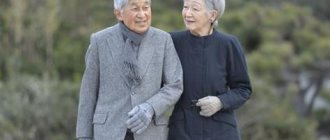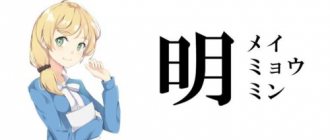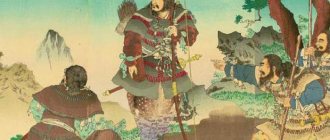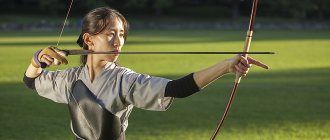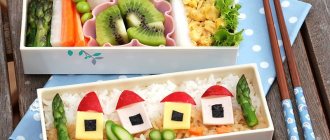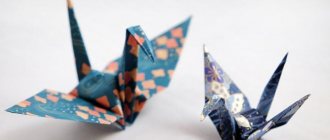To be able to seduce, to evoke love passion and romantic feelings, in Japan they call jojutsu: the art of love. This art is taught to Japanese girls from the age of 6, who become geishas, but these are not prostitutes, as Europeans believe. These are smart, well-mannered and attractive women. The word "geisha" has 2 syllables. "Gay" means graceful, skillful and subtle manner, and "sha" denotes the interlocutor or person. Literally it turns out to be “a skillful manner of communicating with an interlocutor.”
Now girls, in order to learn the ancient skill of pleasing men, do not want to study for many years, which is why they become prostitutes, not geishas.
What is a geiko or geisha?
The word "geisha" literally means "artist" or "artist." Geisha is also known as Geiko, which means "woman of art."
Let's first address the question of what exactly to call them, because I know many of you have heard both terms before:
- People in Tokyo mostly use the term "geisha".
- In Kyoto, the most commonly used term is Geiko.
- Another name for these women is "Geiki", which is most often used in the Niigata area.
- You may also hear the term "Maiko", which refers to young girls who are training to be geisha.
Many people outside of Japan mistakenly believe that geisha are prostitutes, which is a serious mistake.
Geisha are not sex workers. Prostitutes are known by another name - "Oiran".
They wear the same clothes and makeup as geishas, but work completely differently.
Just like their names, geisha are women who practice many traditional Japanese arts, such as singing, dancing, and playing musical instruments.
A geisha's job includes pouring drinks and drinking with guests upon request.
Sometimes they also need to talk to the clients accompanying them.
Japan. Maiko - dancing child
Maiko (Japanese: “dancing child”) is a geisha’s apprentice. Her task is to delight the eyes and ears of guests with songs, dances and playing the shamisen (a three-stringed Japanese instrument). Maiko's age ranges from 15 to 20 years, and they can become a geisha after learning Japanese traditional dances and songs, mastering the arts of conversation, tea ceremony, painting and ikebana arrangement, learning to play the shamisen and learning to speak the Kyoto dialect, regardless of where they come from.
One hour of communication with a maiko or geiko (geisha) in Kyoto costs about $500 per person. (This includes drinks and light gourmet snacks). Time is calculated by the number of burnt incense sticks (one stick burns in an hour). Geisha call the money received for working at a “zashchiki” (party) “fragrant money,” “flower money,” or “diamond money.” If you consider that they usually come to geishas in groups and sit with them for at least two hours, then you can imagine how much the party costs. At least three to four thousand dollars per evening. Mothers (housewives) of tea houses delicately send the invoice to the client only the next day. And the price is never agreed upon in advance; the client is already presented with a fait accompli. Bargaining in such matters is inappropriate.
But geishas also incur considerable expenses. A real handmade kimono (and only these are worn by geishas) costs from $15,000, and its rental for two hours costs from one hundred dollars. Every self-respecting geisha has at least ten kimonos in her wardrobe. In addition to spending on clothes, add the cost of a hairdresser.
Maiko wear classic monumental hairstyles—an elaborate and complex weave of hair that requires an incredible amount of pins, oil, wax, and time. This hairstyle costs about $300. To avoid financial expenses, maiko carefully protect this structure of hair and sleep on special neck supports, hard as stone. The head seems to be hanging in the air. You can't move while you sleep. You can wash your hair once a week, and after a short time, dirty hair begins to emit an unpleasant odor.
There is always someone standing between a geisha and material worries. First, these are the mothers of tea houses, who take in seventeen and eighteen-year-old girls for their upbringing and education. They rent them a kimono and pay all expenses. The girls simply send bills to their tea house. This is partly done intentionally. Maiko should look like a pampered and fragile flower of an old culture, far from real life, a charming doll who has no idea what money looks like.
If the girl is beautiful and smart, then she is a good investment. Having become a successful geisha, she will quickly pay off her debts and bring in a good profit. There is still hope for a danna - a sponsor, patron, patron. This is, as a rule, an elderly and very rich man, ready to take on the costs of maintaining a geisha, pay part of her debts, and is capable of generous gifts. Naturally, unselfishly...
https://vilingstore.net/Otdyh-turizm-oteli-kurorty-c13/Yaponiya-Mayko—tancuyushhee-ditya-i41826
Geisha history
Geisha culture has deep roots in Japan, dating back to the Edo period. During this period, the concept of female courtesans or entertainers developed.
These four historical cultures are what people call the roots of the geisha:
Saburuko
Saburuko refers to the Japanese courtesans of the 7th century. Their work included
- waiting tables
- dance
- talking with guests
- as well as the sale of sexual acts
Many women had to take such jobs due to the difficult economic situation after the Taika reforms.
Shirabyoshi
Around the 12th century, beauty standards changed. Talented dancers in the samurai warrior style are popular.
Thus, Shirabyoshi became a highly respected career. Even highly educated women composed poems and ballads for the performance.
Yuujo
Around the 16th century, prostitution became a legal business. Yujo are "play women" who work in a place called the "pleasure garden."
High-class yujo, called Tayuu, combined erotic dance (kabuki) and acting with a sense of art. Later they became more popular under the name Oiran.
geisha
Artists and talented dancers began to call themselves Geiko. The line has gradually evolved, distinguishing them from Oiran, whose strength is still sex.
As Geiko's popularity grew quite quickly, the brothel became concerned that oiran might lose its relevance.
Consequently, from then on, geisha were prohibited from selling sexual intercourse.
After World War II, many Japanese women dressed up as geishas and offered sexual services to the American military.
They positioned themselves as “geisha girls,” which subsequently led to misunderstandings about their profession.
In 1959, the government banned all forms of prostitution. The law effectively ended the existence of Oiran and the Pleasure Garden.
Only geisha can run a business, but even they are not allowed to sell sexual services to clients.
Who are geishas?
A white face, tiny red lips in a bow, an intricate hairstyle with pins, a Japanese balalaika in her hands... Did you recognize Utamaro (Kitagawa Utamaro), the famous master of ukiyo-e? He loved to make engraving portraits of the fair half of Japanese society in the 18th century. The most significant collection of his drawings dedicated to geishas was the album known as the Yearbook of Yoshiwara's Green Houses. Since then, society itself has undergone colossal changes, and geishas will not be found during the day on the modern streets of Tokyo, which did not exist at that time.
The word “geisha” itself means “person of art.” As you can see, nothing about sponges and bows. This could be an actor, dancer, juggler, singer, in general, any representative of show business who entertains at private parties. And a geisha is not necessarily a woman; in any case, this was not always the case. Until the early 19th century, geisha were both male and female.
After World War II, the word “geisha” acquired a pejorative connotation through the efforts of the occupying forces. This term has simply become synonymous with a woman whose time and services of various kinds can be purchased for a certain amount. In recent years, the word “geisha” has experienced a new wave of popularity among foreigners, largely thanks to various bestsellers, sometimes fabricated by people far from Japanese realities.
How to become a geisha
A geisha needs to have advanced skills and knowledge in many types of traditional Japanese performing arts and culture.
Therefore, training is essential. And even before training, a girl must have some essential qualities if she wants to become a successful geisha.
These qualities include high discipline, focus, dedication and intelligence.
To become a geisha, you need to go to an okiya (geisha house).
Can foreigners become geishas?
Although geisha are traditionally Japanese, foreigners can also enroll as a geisha if they speak Japanese fluently and are willing to undergo training.
Traditionally, girls began their education at a very early age, around five or six years old. Most of them were sold to poor families, and the rest were hired.
They didn't go to school because they had to focus on training geishas.
However, the government made it mandatory for every child to attend school and voluntarily enroll in education.
These days, most people start in Kyoto at the age of 15-16, and in Tokyo around 18. The age of 21 is considered too old to be a maiko.
Therefore, any girl who enters Okiya after age 21 will not debut as Maiko.
She will undergo intense training for a year or so to immediately debut as a geisha.
Where to find geishas?
Tokyo's Yoshiwara entertainment district has long since disappeared. However, finding a geisha will not be difficult in the tea houses of the Kagurazaka, Shimbashi and Asakusa districts.
If you make it to Asakusa, after meeting the geishas, we recommend going on a fascinating walk around the area with our audio guide. .
In Kyoto, the tradition of geisha art is strictly maintained in the Gion and Pontocho areas. Such areas are called “hanamachi”, “city of flowers” (hanamachi). Since the above bestsellers often arouse unhealthy interest among visitors who believe in the veracity of the image of a geisha distorted by pop culture, we urge you to behave respectfully if you do happen to meet one on the streets of ancient quarters.
» ALSO READ ARTICLE – Trip to Kyoto: what to do and see
However, the likelihood of such a meeting is quite low. Most likely, you will see either geisha students rushing to their lessons, or ordinary Japanese or non-Japanese girls walking around in this image created by special ateliers.
Stages of a Geisha's Life
Geisha training requires a lot of effort and care. People usually start at a very young age, so they have plenty of time to perfect their skills.
However, now the training process is much shorter. Some people even take only a year to complete their studies.
Traditional geisha training consists of several stages, including:
Shikomi
Before they begin training to become geishas, girls must work as maids in an okiya (geisha house). The term used for this stage is shikomi.
Although these are just some household chores, their instructors make their work difficult on purpose.
The rigorous training is designed to determine how strong and determined a shikomi is.
If they do this, they can move on to the next stage of learning. But if they fail, they may leave the okiya and forget about their dreams of becoming geisha.
Minarai
Being a minarai means that they no longer have to do heavy household chores. They can begin to learn how to be a geisha by watching how geisha do their jobs.
Minarai cannot yet be invited to parties, but they can attend as plus one senior geisha.
It won't be long before the Minarai process can officially become a Maiko. This usually only takes a month or two.
Maiko
To be a maiko, a minarai must find himself a san-san, a senior geisha, to study the form.
Wan-san means sister. As Minarai enters her process as a Maiko, a ceremony called Misedashi will be performed.
The ceremony bonds Maiko and her Van-san as sisters for life.
The relationship between Maiko and her one-san is vital because Maiko must intensely shade her one-san.
Van-san will take full responsibility for the training and set an example for his Maiko.
The word "Maiko" also means "semi-precious", which refers to the fact that Maiko can be hired for half the price of a fully trained geisha.
Getting hired will give Maiko a chance to meet some of her potential clients later when she becomes a geisha.
geisha
A geisha is a mature woman, ready for a full-time career. To debut as a geisha, you must be at least 21 years old.
Once she becomes a geisha, she can charge full price. She will remain living in Okiya until she retires.
If she has enough resources and abilities, she can even build her own Okiya. A senior geisha can hire Maiko, or at least become Maiko's One-san.
Hiki-Iwai
When a geisha decides to retire, she may undergo some kind of graduation ceremony called Hiki-Iwai. Most geishas retire because they are too old to perform in public.
But sometimes they do it because they want to get married or are simply fed up with the geisha lifestyle.
Geisha training is somewhat military in nature. A high level of discipline is important because training is about improvement. They teach in detail how to act as a geisha.
It is now clear why geisha training will be much more effective if the process begins at a very young age.
From Maiko to Geisha
The transition from maiko to full-fledged geisha is like a graduation because it marks the end of her training.
The transformation also means that the girl now enters adulthood as a woman. To mark such an important milestone, there are processes called Mizuage and Erikae.
mizuage
Mizuage is a ritual of defloration or loss of virginity. Every time Maiko completes her training, Okiya will hold an auction for her loyal guests.
Any man who makes the highest bid gets the right to deprive his mother of Maiko and become her Danna (patron).
The money paid by Danna will be given to Okiya as "payment of debt" for all the expenses that Okiya had to spend on training a particular Maiko.
However, after a night of Mizuage, the geisha no longer needs to have sex with her Danna or any of her clients.
Traditionally, Mizuage is a mandatory process that every Maiko must undergo to become a geisha.
But in 1959, the Japanese government declared the practice illegal because the concept was similar to prostitution.
Currently, Mizuage is simply a process of accepting sponsorship from Danna without the obligation of sexual favors.
Many Maiko even become geisha without the Mizuage ritual.
Erika
Unlike Mizuage, Erikae is still practiced by every Maiko because the step is more important and not related to sexual matters.
Erikae is a formal ceremony that marks Maiko becoming a geisha. At this point, Maiko will also receive a stage name for use as a geisha.
The ceremony mainly involves changing hairstyles and clothing because Maiko dresses differently from a geisha.
Erikae usually occurs a few months after Mizuage. After her Erikae, a geisha can now receive full payment when a client hires her.
What kind of sex education did the geiko receive?
A geisha’s ability is to use her gaze, facial expressions and gestures to attract a man so that he wants her as soon as he sees her, but the rules of these women are to choose lovers on their own. Attention is paid to generous and devoted men who care reverently and do not retreat, waiting for reciprocity. The geisha, who gave the gentleman a positive answer, endowed the man with fiery and unforgettable passion, using jojutsu: the art of love.
To satisfy her lover, she trained her vaginal muscles to:
- Attract and retain a partner. An experienced woman knows how to control these muscles.
- Increase self-confidence. Stretched vaginal muscles lose their love power. Muscle tone accumulates energy, making a woman attractive.
Trained intimate muscles help both partners achieve the highest pleasure.
A set of wumbling exercises for training the vaginal muscles:
- Contract the muscles of the anal and vaginal passages 10 times alternately. Then 10 sec. keep both muscles tense at the same time, then 10 seconds. relax.
- Squeeze your intimate muscles 10 times in a row without stopping. Repeat after rest
- The same, but slowly for 5 seconds. After the break, hold the tension for 20 seconds.
- Strain your intimate muscles, trying to hold an imaginary object inside. Start with 10 seconds, working up to 5 minutes.
- Tighten your muscles with medium effort, after 5 seconds. squeeze harder, then, after another 5 seconds. add tension. Relax also with breaks.
- Lying on your back with your legs bent and slightly apart for 2-3 minutes. raise and lower the pelvis. The same, but when lifting, tighten the vaginal muscles.
- Push with moderate force as during contractions.
The daily norm is up to 150 movements, performing exercises in 3-5 sets, 3 times a day.
A geisha understands a lot about erotic relaxing massage, knows the techniques and technique of performing it, giving pleasure to her partner. Such a light massage is done not only with your hands - they gently or passionately touch you with your lips, or gently move your nipples. Using only their lips, geisha bring men to a convulsive state. They dig in, suck in, bite and bite and know that the main erogenous zone for a man is in the groin area.
The massage is performed with relaxing music and lit incense sticks. You are allowed to light an aroma lamp with oils that awaken passion: ylang-ylang, cinnamon, patchouli. For massage movements, measured and rhythmic movements are used, caressing the erogenous zones on the chest and neck, between the shoulder blades, on the inner surface of the thighs, in the popliteal fossae and the penis and testicles.
The order of massage techniques:
- Lubricate your hands with softening cream or oil.
- Massage your shoulders, then your lower back and back of your legs.
- Starting from the navel, gradually move upward or to the sides, making circular movements.
- The nipples are massaged carefully, touching lightly and gently, preferably with the lips.
- The genital organ is slowly stroked, sometimes again massaging the chest, neck and legs.
Massage gives way to sex. A true geisha manages to guess what her lover is waiting for, and her trained vaginal muscles are sensitive to her partner’s desire. In bed, a geiko is a performer of men’s whims, without intruding on personal relationships. Knowing how to entangle a man with strong and invisible networks, secretly taking possession of the soul and brain, she binds a lover who is already afraid of losing her.
Using hypnosis techniques, like a secret love spell, with copying gestures, facial expressions and words, they influence the subconscious level of a man and establish contact.
With the help of the listed simple techniques of jojutsu, the art of love, a model appearance and beauty are not even required - these techniques are skillfully mastered by a seductress, a skilled geisha.
Geisha skills
Geisha training requires a lot of effort and care. A girl must have discipline, determination and even wit.
Without them, it would be impossible to complete the training. Almost every little aspect is taught, including:
Makeup, hairstyle and outfits
This goes without saying. Geisha and even Maiko in training have a specific appearance. Their style is not easy to pull off.
Conversation with men
Cheerful conversation is the first way to charm men.
Geisha/Maiko need to learn about the person's ego and how to make them feel comfortable through light conversation over drinks.
Walk
It is not easy to walk in wooden shoes. On the other hand, a geisha should always be kind.
Learning to walk is one of the most important exercises, but it is not easy.
Dream
Forget about a fluffy cotton pillow. Such a thing will ruin the neat hairstyle of a geisha.
After debuting as Maiko, she will have to learn to sleep using the Takamura, a small cylindrical pillow that can be placed directly under the neck.
Using a neck support like this allows the maiko/geisha to relax her head without ruining her hairstyle.
However, many geisha these days wear wigs to give their hair a sophisticated look. Hence, they can sleep normally using the pillow by simply removing the wigs.
Laugh
It is not graceful for a Japanese woman to laugh with her mouth open. Therefore, a geisha should cover her mouth when laughing.
They can use a traditional hand fan or simply use their hand for this purpose.
Geisha Games
A geisha should also know a few geisha games to play with her guests during dinner. Games are designed to lift your spirits.
Geisha games are usually fun to play, especially because guests must drink a shot if they lose as punishment.
Art Performance
A geisha dinner usually includes an artistic performance, whether a small one-man show or a large stage performance.
During her training, a maiko must learn several Japanese arts, such as singing, dancing, and playing instruments.
But later, when they grow up to be geisha, many of them tend to specialize.
Japanese culture
Knowledge of Japanese culture is very important because many guests like to talk about it during conversation.
How much do geishas get paid?
No one knows exactly how much geisha and maiko can earn per month.
It is estimated that a good geisha can charge between $3,000 and $10,000 per month, depending on skills and experience.
However, they also have to spend a large amount on purchasing kimonos and hair ornaments, which are known to be very expensive.
It is known that Maiko will receive virtually no salary at the beginning of her debut. Maiko training is expensive.
Okiya is investing approximately $500,000 in the education and training of maikos. This amount includes fashionable kimonos and luxurious hair jewelry.
Therefore, the money Maiko earns usually goes to Okiya as restitution.
Clients must pay for the maiko they hire. The rate is usually about half that of a geisha.
But the money will go to Okiya until all training costs are paid off.
Most Maikos will not make any income until at least three to four years after debuting as a Maiko.
Hairstyles
For the debut, the minarai have a special hairstyle called “misedashi wareshinobu”, which is distinguished from the simple “wareshinobu” by two ogi (wide aluminum pins to which strips of metal are attached) and “chirikan” decorations in the form of ribbons at the back.
Misedashi wareshinobu:
Wareshinobu is the hairstyle of young maiko for the first three years of training.
There are more decorations than on wareshinobu, only on festive hairstyles. The back of the hairstyle is called 桃割 "momoware", which means "broken peach" and is a hint of what is located between the girls' legs.
Momovare:
Some Japanese still find momovare somewhat provocative. The hair, collected in a round roller, is separated in the middle by a “kanoko” - a red ribbon. A round pin made of tortoiseshell is stuck into it from above.
In the old days, changing one's hairstyle to ofuku occurred after mizuage, the loss of virginity, at about 13-15 years of age. Since the change in hairstyle was quite significant, Maiko Ofuku seemed very embarrassed, because now everyone would know what happened to her!
Nowadays, mizuage is not carried out, and the change occurs on the maiko's eighteenth birthday or three years after the start of training.
Ofuku:
From the front, the ofuku is very similar to the wareshinobu, although they are distinguished by a red kanoko ribbon, dividing the momovare in half, but absent from the ofuku. At the back there is now 縮緬てがらみ "chirimen tegarami", a triangular ribbon that is simply pinned, unlike the ribbon woven into the wareshinobu's hairstyle. Maiko wears this hairstyle until her eri-kae is two to four weeks away. Then she will wear her sakkoo hairstyle.
At twenty-one, or earlier if the okaasan feels that the maiko is skilled enough, preparations begin for the maiko for the collar changing ceremony, eri-kae. This day will be the day of her debut as a full-fledged geisha. A month or two weeks before, her hair is styled in a sakkoo style. She is easily recognized by the ponytail hanging at the back of her hair; The tip of this ponytail is cut off by okaasan on the first night of debut.
Sacco:
Another hairstyle for older maiko is called “katsuyama”, it is worn at gion matsuri. Katsuyama is the taiyou who created this hairstyle. Katsuyama wear special jewelry - pink and silver kanzashi "bonten". The location of the kanoko also changes - it now braids the top of the hairstyle.
Katsuyama:
Yakko-shimada is the hairstyle of older maikos for the New Year, Setsubun, and the first of August, Hassaku, “thank you day.” At the back, the protruding part of the hairstyle is braided with beads made of red and green beads and a wide shibori ribbon 絞. Setsubun (節分 setsubun) is a celebration of the beginning of spring, February 3rd. Hassaku (八朔) is a celebration of respect. Held on the first day of the eighth lunar month. The maiko and geiko thank everyone in their o-chaya, the okiya owners, and so on.
Okiya
The okiya is the home where all geisha live from the time they are first recruited. Okiya is run by a senior or retired geisha called Oka-san (mother) or Okami-san.
Several maiko and geisha can live in a boarding house at the same time, and there may also be no one in it.
In ancient times, okiya sold girls or hired them at the age of 5-6 years. People believed that training throughout your life would bring you closer to perfection.
But according to the law, girls must be at least 15 years old to be hired at Okiya. Even Okiya needs a formal license to operate legally.
The relationship of all geishas in Okiya is like a foster family.
Okami-san will be the Mother. The older geisha will be One-san (sisters) to Maiko and the younger geisha.
When Okami-san dies, the older geisha living in Okiya can take her place as the new Okami-san.
Okiya has everything you need for geisha training and practice, including clothing, makeup and art.
Okiya is also responsible for paying all the expenses of all the people living there, including Maiko's training.
It is also the Okiya who determines who Ochaya Maiko and Geisha will work for.
Although this place can be very welcoming for girls, boys are strictly prohibited from living there. A geisha who is married must leave her Okiya to live with her husband.
Even if a single geisha becomes pregnant and later gives birth to a son, she will have to choose: give up her son to be adopted by another family, or leave her Okiya so she can raise her son on her own.
Ochaya
The word Ochaya means "tea house". This is a traditional establishment for all Geisha entertainment services.
It offers tea, alcoholic drinks, artistic performances and geisha escort services. Similar to Okiya, Ochaya also requires a license to operate legally.
Ochaya doesn't have the same system as regular bars or restaurants. They will not bill their guests for each visit.
Instead, they will recalculate all expenses spent by guests and send a monthly savings account. This system is the reason why a circle of trust among guests is vital.
Traditionally, not everyone has the right to access Ochai. The space is by invitation only.
Existing Ochaya customers can refer their friends to be invited to Ochaya. But if a guest causes trouble, his direction will be held accountable by Ochaya.
Therefore, guests will not refer random friends to Ochaya because it may affect its reputation.
Also, you need a very rich person with a good reputation and social status to find someone who would be willing to refer you to Ochaya.
However, as businesses become increasingly difficult to survive, Ochaya becomes less restrictive over time.
In this era, some travel agencies can send tourists to Ochaya if they pay at least a certain amount of money that Ochaya requests.
Translation services are also available for non-Japanese speaking guests of Ochai.
Geiko or Maiko Dinner
Ochaya has indoor tatami rooms where you can enjoy a full traditional dinner with a Maiko or Geiko.
Customers can order how many Geikos and Maikos they want in their cells.
Diners should not be left alone at this dinner. Often men like to have a group dinner with their buddies to have fun together.
Dinner will begin with light conversation and drinks. The selection of drinks is varied, from traditional to modern, both alcoholic and non-alcoholic.
Geiko or Maiko will refill your cup every time it is empty. They can also drink if you say so.
Geiko and Maiko have learned to be interesting conversationalists. They even learned about the male ego to learn how to charm them through communication.
Moreover, Maiko and Geiko also learn about trends among men to stay relevant all the way.
Dishes are usually served in a sophisticated presentation with meticulous details to make your dining experience top notch.
Of course, the menu will consist of authentic Japanese dishes, mainly seafood.
Of course there will also be Geiko/Maiko performances. This could be instrumental music playing, singing or dancing.
Guests are expected to behave respectfully during the performance.
To get the best gaming experience, Maiko/Geiko will also invite customers to play some traditional Geiko games.
The winning buyer may receive small prizes. But if he loses, he should drink beer as punishment.
A geisha's responsibility is to make her clients feel comfortable saying whatever they think.
Geisha and Maiko have a strict code of keeping their clients' secrets.
Whatever they hear and see from their clients cannot be shared or discussed even with other geisha.
The history of the appearance of geishas
Maiko and geiko
Geisha have been entertaining influential guests visiting tea houses since the 13th century, but until the 18th century, this role was performed by men. The first female geisha appeared in 1752, and since the 19th century, the geisha profession was already considered an honorary profession for women. To put it correctly, a geisha is a man, and a female geisha is called a geiko.
At the same time, beautiful kunoichi or geisha ninjas appeared. Just as adept at entertaining and seducing male society, these women were destined for murder.
When the war was going on, living in hunger and poverty, girls-prostitutes had to call themselves geishas in order to attract American soldiers with an exotic name. Underage girls - maiko, which means students and inexperienced geishas, applied a layer of white paint to their faces, but dressed like experienced geikos. Experienced geishas rarely used whitewash, only on special occasions and before the age of 30; they often painted like other Japanese women and dressed conspicuously. An experienced geisha is an elegant, dignified adult woman with refined charm and skills, and in the image of a maiko you can see a charming, sweet girl. Not having mastered the refined art of dancing and conversation, maiko attracted guests with bright outfits: colorful kimonos, floral stilettos, sandals with bells hung on them.
Experienced geishas, distinguished by intelligence and beauty, are considered to be 50-60 year old ladies. The oldest geisha is 94 years old, Yuko Asakusa, who has been working for 81 years. This woman’s art is affordable for politicians and business clients.
Before there were geishas, men were entertained by a group of female shirabyashi dressed in men's samurai clothing and white makeup. According to assumptions, such clothing was required to lure samurai, because they chose boys for lovemaking. Shirabyashi were recognized by the bald spot on the top of their head.
In addition to female geishas, there are still male geishas (husuto). Since the 1960s, these artists have been invited to entertain wealthy women and the wives of influential men.
Geisha clothing and makeup
Geisha have a laconic and sophisticated appearance. There are strict rules and regulations regarding their clothing.
There are differences in the appearance of geisha, maiko, oiran and even ordinary Japanese women.
Here's how to tell a Geisha and a Maiko apart by appearance:
Kimono
While common people wear kimonos that cover the neckline, those worn by geishas/maikos expose the back of the head.
This impact appears to be sensual in Japanese culture.
You can identify Maiko by the red color of their collars. Also, maiko kimonos are usually brightly colored with intricate embroidery.
They look just as cheerful and young. The sleeves are soft and long, sweeping along the ground when Maiko lowers her arms.
Geisha wear a white collar. Unlike maiko, geisha kimonos are mostly solid and bright in color.
The designs are more minimalistic and are usually located around the bottom of the kimono. In general, geisha clothing is more attractive. Even their sleeves are shorter.
Obi
The obi is a large fabric belt used to keep the kimono neat. Geisha usually wear an Obi that is brighter than their kimono to bring out the color.
Do you get new cooking tips in your inbox every month?
Japanese recipes, cooking tips and more in your first email with our FREE mini-recipe "Japanese Made Easy"
We will only use your email address for our newsletter and respect your privacy
A Maiko's obi is usually larger and more extravagant, while a geisha's is narrower and simpler.
Both Geisha and Maiko tie their sash at the back, while the oiran ties it at the front for ease of access.
The Maiko knot is more complex. They need the help of another person to do it for them.
Shoes
The most unique part of Maiko's appearance is her shoes. The high wooden sandal platform called Okobo is not easy to walk on.
Meanwhile, geisha have a much easier time walking because they only wear flat sandals called Ziro. Both Geiko and Maiko also wear a type of sock with buttons called tabi.
hairstyle
Both the geisha and Maiko have elaborate hairstyles, adorned with kanzashi (hairpins).
Maiko are still required to wear their natural hair, but geisha have the option of wearing wigs to keep their hair simpler and healthier.
A simple geisha bun is known as Shimada. Meanwhile, Maiko has five different buns for each step of the workout.
They
- Wareshinobu
- Ofuku
- Momoware
- Katsuyama
- and sacco
Nagajuban
Nagajuban is a thin garment used as underwear.
When wearing a kimono, most geisha and maiko would not wear modern underwear, as it would disrupt the lines of their kimono.
Maiko usually wears red, while Geiko can wear any other color.
Although formal kimonos may have 12 to 20 layers, geisha and maiko do not wear that many. As mentioned above, just a few layers.
However, on a more formal occasion, their kimono and hairstyle would be much more extravagant.
Makeup
Geisha and Maiko are easily identified by their ivory-colored faces, called oshiroi, and their bright red lipstick.
Some older geisha stop wearing oshiroi as they get older. On the other side of the cycle, maiko usually have thicker oshiroi at the beginning of training.
Makeup begins with a layer of wax or oil called bintsuke-abura, which is applied as a base. Then oshiroi can be applied to the entire face, neck, and back of the head.
The paste is a mixture of white rice powder and water.
After applying oshiroi, the geisha and maiko finish off the makeup with red lipstick, neat brows and sharp eyeliner.
The reason for this extreme color is that white is considered the color of perfection.
In addition, oshiroi can hide any imperfections on the face, such as pimples and wrinkles.
Makeup becomes less important for older geishas as they already have enough charms such as conversational intelligence and artistic skills.
Tayu and Oiran
In the old days, taiyu: 太夫 (in Kyoto) and oiran 花魁 (in Tokyo) were high-class courtesans. They came to the ceremony before the geishas and the client had a choice: try his luck with the courtesan (and she could easily refuse) or stay to have fun with the geishas (but without sex). This led to the fact that Tayu and Oiran began to create very complex hairstyles, with dozens of hairpins and other decorations, and also wear three or more kimonos. There is a misconception that the taiyu belt is tied in the front because it is easier to untie.
Kisaragi taiyu: gave an interview in which she explained that the point here is that taiyu: are aristocrats, unlike the same geishas, and the belt in front prevents them from doing any kind of work. For prostitutes, the belt was tied in front with a simple knot. The collar of the taiyu kimono is always slightly turned back on the right, showing an exciting red underside. And yet, despite the sexual aspect, taiyu: and oiran were as skilled as geishas, and in some types of art they even surpassed them.
Oiran student: Experienced Oiran:
Now prostitution in Japan is prohibited, and oiran and taiyu: only art remains. Unlike geisha, who are on the rise again with the rise of the Internet (some hanamachi report that they have no room for new maiko), blogging and publishing elements of their world, ceremonies, dances and photographs for everyone to see; allow you to post videos from hairdressing salons and your homes on popular resources; give interviews and star in commercials, taiyu have fallen behind in this race: there are now only five taiyu in the world:.
Taiyu: and oiran whiten the entire face, like a maiko, and taiyu: they also blacken the teeth according to the ancient Japanese tradition. Oiran look somewhat more reserved, sometimes they are even confused with geisha. Taiyu: shows an abundance of yoshicho (forked flat stilettos) and the obligatory presence of gold color in clothes (specifically, in the uchikake cape). Tayu is also worn on two heels with long red threads, each with a coin attached to it. Tayu and oiran shoes are very high black sandals with three heels, which require very small steps.
Oiran procession:
Get your own geisha kimono
Kimonos are not cheap clothes, especially those worn by maikos and geishas. Prices vary depending on the fabric used and the complexity of the embroidery.
For geisha and maiko, the best option is organic silk products. With intricate embroidery, one set of kimono can cost over $10,000.
However, a regular silk kimono only costs between $240 and $800. As a cheaper option, you can choose artificial silk material.
A brand called Silluk offers a rayon kimono set for just $150 or a little more.
In winter, wool kimonos can provide more warmth and comfort. Price from 240 dollars.
But if you only look for regular kimonos, like what regular women wear, they will only cost about $40 each for one in cotton.
Instead of purchasing, you may want to consider renting if you only need to wear the kimono once.
In Japan, especially Tokyo and Kyoto, you can find many kimono rental companies.
The fashionable silk kimono worn by geisha and maiko rents between $34 and $50.
You can even ask the company for makeup and photoshoot services for a small additional fee.
After hours
The personal life of a geisha today is very different from what it was in ancient times.
In general, geisha today have more freedom and ease to live a happy personal life, while the ancient geisha had to face some rules and consequences in order to live the life they want.
Contracts between geisha/maiko and their okiya (nenki) are much simpler and easier these days.
Therefore, in their free time, they can do whatever they want, including wearing modern clothes and going to the mall.
Maiko currently has two days off a month. Geishas are free to set their own work schedule. Even a maiko in training can still attend high school.
Geisha and Maiko have the opportunity to quit smoking at any time. Many Maiko did not even debut as full-fledged geisha.
Moreover, most geisha decide to retire between the ages of XNUMX and XNUMX, mainly because they want to get married and start a family.
The world of geishas and yujo karyukai
Any national costume in one way or another reflects the characteristics of the material and cultural life of the people, including the national character. Geisha clothing stands apart. In general, geisha are like the last stronghold, the keepers of kimono traditions and the only ones who wear kimonos both at work and just at home. Since geisha are special creatures, their clothes are a strange mixture of different characteristics.
Basically, the outfit of a maiko (geisha in training) is similar to furisode . It also has long sleeves that reach to the floor, bright colors with a pattern all over the field, which emphasizes youth. The neckline of the collar is wrapped high at the neck, the scarf peeks out strongly from under the obi, the cord is tied just above the middle. But at the back of the collar it is lowered almost to the beginning of the shoulder blades (which is sexy according to their concepts). Also, maiko wear only the full version of the obi - the maru obi with a very large knot.
Seasonality. This is a very interesting aspect of wearing a kimono. Everything here is also very complicated, but in short, wearing a kimono according to the seasons not only reflects the needs of the weather, but also has an aesthetic meaning. Each season has its own fabric and its own designs. All kimonos are divided into simple ( hitoe ) and lined ( awaze ). Hitoye is worn from June to September, the rest of the time - avaze. Previously, there was even a special ceremony of koromogae - a change of wardrobe, when clothes from one season were put away and others were taken out.
Next comes the material and color, and lastly the design. Each season (a couple of months) has its own pattern, and the general rule is this: the type, fabric and color of the kimono should correspond to the month of wear, but the pattern should be from the next month, should always, as it were, anticipate the coming season. If this is not the case, then this is an indicator of emotional poverty and poor taste of the carrier. All this together allows you to adapt to specific weather. For example, if October (autumn month) turned out to be hot, then you can continue to wear a hit, but then you should choose darker colors and a clearly autumn pattern (leaves, geese, orchids). Or if May (spring) is hot, then you can start wearing something ahead of schedule, but it should be made of thick crepe, because... It's not time to wear silk yet.
The combination of obi and kimono is also determined by seasonality, so it is impossible for both to have the same motif. The motives should be different in appearance, but combined on a more subtle level. For example, a kimono with cranes + an obi with a tortoiseshell pattern (a turtle and a crane are symbols of longevity), or a kimono with flowers + an obi with waves, or a kimono with a river wave + an obi with stylized water irises (c) color-harmony.livejournal.com
Sex, love and family
Sex is not part of a geisha's job description, especially since the Anti-Prostitution Law was passed in 1959.
Sometimes a geisha agreed to sleep with her client or with anyone. This is all her personal decision.
Keep in mind that demanding sex with the geisha/maiko you hire during dinner would be extremely disrespectful.
Falling in love is a common occurrence among geishas, both in ancient times and today. However, relationships are a different matter.
Previously, a geisha had to leave the profession and first pay off her debts if she wanted to get married.
Getting pregnant out of wedlock was also a problem in the old days.
Since boys are not allowed to live in Okiya, the geisha must choose between giving him up for adoption or leaving her Okiya forever to raise him herself.
If the child turns out to be a girl, she may have to become a geisha in the future if her mother raises her in Okiya.
With such restrictions, most geisha in ancient times chose to remain single for the rest of their lives.
Some managed to fall in love and get married, especially those who were romantically involved with their patron.
Logically, it should be easy for the patron to pay off the contract with the girl with all the wealth he possesses.
Meanwhile, these days, married women, even those with children, can continue to work as geishas without suffering serious consequences.
Nowadays, it is quite common to see geisha and maiko having romantic relationships with everyone they love.
Since nenki is much simpler, a geisha does not need a very rich man to pay for it.
How to meet a geisha
The number of geishas has declined sharply over the past few decades.
How many geisha are there in Kyoto?
The exact number is unknown. It is estimated that there are about two hundred geisha in Kyoto. There are about four hundred of them in Japan. There used to be about 80,000 1920 in 1,000, but now there are only less than 1,000 geishas.
If you're traveling to Japan and want to see them, there are many options to consider. Here they are:
In Hanamichi
Hanamichi is a geisha district. In this area you will most likely find Okiya, Ochaya, Ryutei (restaurant), places where Maiko receive artistic training, and some other things necessary for a geisha business.
There are six Hanamichi in Tokyo and five in Kyoto.
To have the best chance of meeting a geisha and maiko walking on your way to work, try staying in the area between 5:30 and 6:00 pm.
Although this trick is the cheapest way to meet a geisha/maiko, you don't have many chances to interact with them.
You may not even be lucky enough to get a suitable photo with them.
At the festival
There are many cultural festivals in Japan, which many geisha/maiko also attend. Here are a few festivals and holidays you can take a chance on:
- Fair Asakusa Toshi no Ichi
- Kagurazaka Street Stage Edo Tour
- Yasaka Setsubun Shrine
- Higashiyama Hanaturo Festival
- Kyoto Gion Festival
The festival can be crowded and crowded.
Even if you are lucky enough to spot a geisha or maiko, chances are you won't get a good photo or a pleasant conversation with them.
During the performance
Odori is a traditional dance performance. Tickets are very affordable, ranging from $15 to $50 per person.
This is the best way to see geisha and maiko while observing their well-trained talents.
There are many Odori schedules in many places in Japan, so you can easily find one that suits your visiting dates.
However, it's best to check the schedule and book your ticket in advance to avoid missing out.
Book dinner Geiko
A geiko dinner is undoubtedly the best chance to meet a geisha. Because not only will you be able to take a photo, but you will also have a fun and long conversation with them.
The geisha and maiko you hire will dance privately for you or your group in a tatami room.
Although Ochayas are not as strict as they used to be when accepting new clients, you still need a lot of money to make this happen.
Many travel agencies offer geiko dinners with minimum rates ranging from $200 to $450 per session.
Additional charges may apply, especially if you order more food, drinks or geisha/maiko to accompany your evening.
